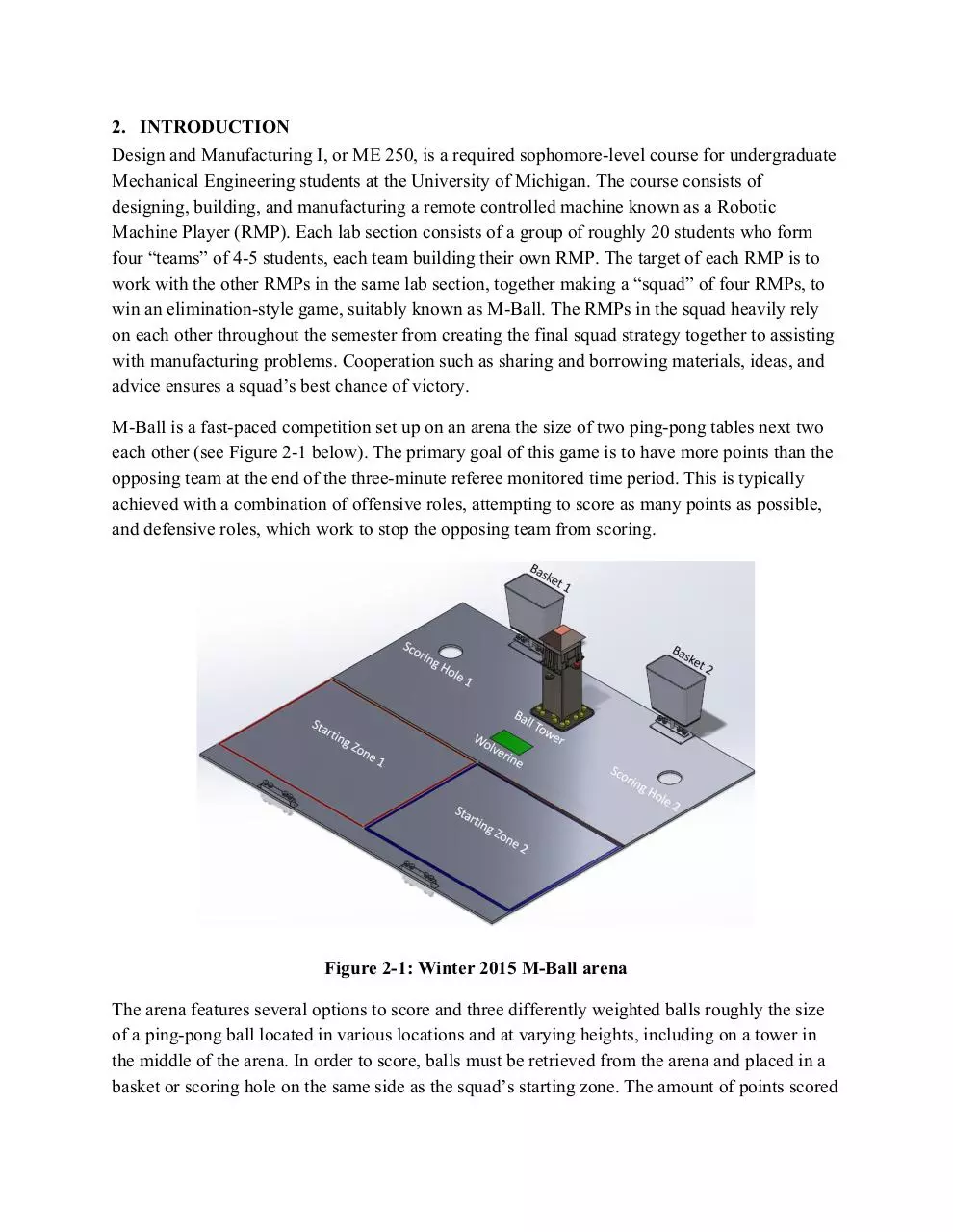ME250FinalReport Team74 (1) (PDF)
File information
This PDF 1.5 document has been generated by / Skia/PDF m53, and has been sent on pdf-archive.com on 01/07/2016 at 00:56, from IP address 73.18.x.x.
The current document download page has been viewed 483 times.
File size: 2.14 MB (53 pages).
Privacy: public file





File preview
ME 250 DESIGN AND MANUFACTURING I
Winter 2015
Design and Manufacturing of a Robotic Machine Player
for the ME 250 Winter 2015 MBall Competition
April 21, 2015
ME 250 Section #07, Team #74
Team Members
Yousef Al Shomaly
Lauren Hutchins
Demetri Kanellopoulos
Phil Towne
TABLE OF CONTENTS
Contents
ABSTRACT
INTRODUCTION
PROTOTYPE DESIGN
3.1 Squad Strategy Selection
3.1.1 Team Strategy Selection
3.1.1.1 Strategy Concept 1 (see Appendix A.1)
3.1.1.2 Strategy Concept 2 (see Appendix A.2)
3.1.2 Squad Strategy
RMP Requirements
RMP Conceptual Design
Detailed Design
Analysis Model
Final Design and CAD Model
PROTOTYPE MANUFACTURING
Manufacturing Process
Bill of Materials (BOM)
PROTOTYPE TESTING
Preliminary Test and scrimmages Results
Redesign Based on Preliminary Tests and scrimmages
Discussion of Competition Results
DISCUSSION AND RECOMMENDATIONS
6.1. Project summary
6.2. Future project idea
REFERENCES
ACKNOWLEDGEMENTS
CONCEPT SKETCHES
Dimensioned Drawings and manufacturing plans
1. ABSTRACT
Throughout the Winter 2015 semester, students in ME 250, a sophomorelevel course offered at
the University of Michigan, worked in teams to create a remote controlled machine, known as a
Robotic Machine Player (RMP). In ME 250, the main goal of each team is to win a game
designed by the instructors of the course, formally known as MBall. Each lab section works
together and forms a “squad” consisting of four teams that collaborate on strategy, designating
each RMP’s roles in working for the squad’s success.
This report serves as an overview of the design process our team underwent throughout the
semester in order to design, analyze, and manufacture our RMP. The report begins with a
summary of the constraints encountered this semester with a brief description of the MBall
competition rules and the organization of the ME 250 course. A breakdown of the entire design
process will be given, involving the development of team and squad strategies, collaboration, and
selection. An analysis of the advantages and disadvantages of our squad’s strategy will be stated,
with our team’s specific role accentuated.
After our design problem and constraints have been defined and the role of our RMP is
understood, this report will describe the numerical and functional requirements our team
assigned to our RMP. In addition, three preliminary concepts, illustrations, and detailed
descriptions will be shown. Our team went through a significant process to choose a design that
would meet our requirements. We extensively used computeraided design (CAD) to show
dimensions, functionality, and other important features while developing the final RMP design.
This report highlights specific analyses taken to confirm the functionality of our final conceptual
design. We calculated a static analysis on components of our RMP, a motor analysis for all three
motors used to power our RMP, and a torqueload analysis on our most critical module (MCM).
The report will list modifications to our design made before manufacturing as a result of these
calculations.
After the analysis portion, this report will discuss the issues, difficulties, and changes made
during the manufacturing processes. To check functionality before the competition, preliminary
tests were done, resulting changes to our design will be described in detail. Also included will be
engineering drawings for every manufactured part of our RMP and a bill of materials. A
summary of the entire design, build, and test processes for our RMP is highlighted in this report,
along with a critique of our final design. An analysis of the advantages and disadvantages of the
design, its performance in the MBall competition, the outcome of the competition, and an
overview of the entire semester will also be emphasized.
2. INTRODUCTION
Design and Manufacturing I, or ME 250, is a required sophomorelevel course for undergraduate
Mechanical Engineering students at the University of Michigan. The course consists of
designing, building, and manufacturing a remote controlled machine known as a Robotic
Machine Player (RMP). Each lab section consists of a group of roughly 20 students who form
four “teams” of 45 students, each team building their own RMP. The target of each RMP is to
work with the other RMPs in the same lab section, together making a “squad” of four RMPs, to
win an eliminationstyle game, suitably known as MBall. The RMPs in the squad heavily rely
on each other throughout the semester from creating the final squad strategy together to assisting
with manufacturing problems. Cooperation such as sharing and borrowing materials, ideas, and
advice ensures a squad’s best chance of victory.
MBall is a fastpaced competition set up on an arena the size of two pingpong tables next two
each other (see Figure 21 below). The primary goal of this game is to have more points than the
opposing team at the end of the threeminute referee monitored time period. This is typically
achieved with a combination of offensive roles, attempting to score as many points as possible,
and defensive roles, which work to stop the opposing team from scoring.
Figure 21: Winter 2015 MBall arena
The arena features several options to score and three differently weighted balls roughly the size
of a pingpong ball located in various locations and at varying heights, including on a tower in
the middle of the arena. In order to score, balls must be retrieved from the arena and placed in a
basket or scoring hole on the same side as the squad’s starting zone. The amount of points scored
depends on the weight of the ball, 2.5, 24, or 55 grams, and the height of the zone the ball is
deposited in. When a ball is deposited in a tall basket at the back of the arena, the corresponding
squad earns twice the ball’s weight in points, while the shorter front baskets earn 1.5 times the
weight in points, and the scoring hole cut out of the arena floor earns a point for each gram
deposited in it. Additionally, a team can be awarded 75 points if the wolverine is over the
opponent’s hole at the end of the game.
At the end of the competition, whichever team has scored the most points wins and advances to
the next round of the tournament, if applicable. There are also a strict set of guidelines that each
RMP and squad must follow, including prohibited RMP materials, required starting dimensions
and weight, and unacceptable game conduct. In order to ensure a victory, the four RMPs in each
squad must be in constant communication and coordination.
The objective of this project was to create a RMP that can work with the rest of the squad to
achieve victory while teaching students basic design and manufacture practices by providing
handson experience. Our team was responsible for designing and building a RMP capable of
collecting balls from any height and being able to deposit them into either basket, with a focus on
the front perch balls and the front basket.
3. PROTOTYPE DESIGN
3.1 Squad Strategy Selection
The final strategy selected by our squad was a combination of each team’s best ideas. After compiling the
best strategies of our individual teams, our squad created two strategies. One strategy had a focus on
controlling the tower with one RMP, while the other strategy had two RMPs scoring in both baskets. We
discussed which strategy we thought would score us the most points while also providing the strongest
defense for our team. We also took into consideration the flexibility of the strategies. After a thorough
discussion with our individual teams, we each voted on the strategy we thought would be the most
successful.
3.1.1 Team Strategy Selection
Before meeting with our squad to decide our final strategy, our team brainstormed our own individual
ideas for the roles of each RMP in our squad. We each created three distinct strategies, relayed each of
our our individual ideas to each other, and critiqued them. After our individual brainstorming, we had
twelve different strategies to choose from. We selected and combined the best ideas from each strategy to
form three strategies which we felt would give us the best chance at victory.
3.1.1.1 Strategy Concept 1 (see Appendix A.1)
The first strategy combines offense and defense, with two RMPs playing a primarily offensive role and
two focused on a defensive role. RMP1 will be covering the scoring hole in order to ensure that the other
squad does not block our hole or prohibit movement of the tower. RMP2 will focus on moving the tower
towards our hole and ensuring that all of the pingpong balls inside the tower fall into our hole. After the
tower has been moved, RMP2 will gather the balls from the tower perches. RMP3 will be responsible for
the movement of the wolverine and protecting the opposing squad’s scoring hole, while RMP4 will be
responsible for defending the opponent’s baskets. RMP4’s role will be versatile, and will be allowed to
move freely around the arena and assist with scoring points or defense when necessary.
This strategy has several advantages, the primary one being the ability to score the maximum amount of
points with both the PingPong balls inside the tower and the balls on the perches. In addition, RMP3 and
RMP4 have very versatile roles. This will allow our squad to respond very quickly to movements made
by the other team. However, this strategy may be hard to implement since the majority of the action is
taking place at the far end of the arena. It also may be difficult to defend against an offenseheavy team
and control the wolverine for the duration of the game.
3.1.1.2 Strategy Concept 2 (see Appendix A.2)
Our second strategy also focuses on controlling the tower, but is more defensive in nature. RMP1 would
be responsible for gaining control of the tower and moving it over our hole. RMP2 would be responsible
for traveling to the opponent’s two baskets and removing balls from the basket that have already been
used to score, while RMP3 would be focused on covering the other team’s scoring hole. RMP4 would
play an offensive or defensive role to aid other RMPs in the squad, depending on the current situation of
the game.
The main advantage of this team is its strong defensive strategy, which will ensure that the opposing
squad will have trouble finding the opportunity to score any points. The versatile role of RMP4 is also a
major asset to this strategy. This strategy does not account for the wolverine and only allots for one RMP
to control the tower and move it over our hole. Unfortunately, if the opposing team is offenseheavy, they
could score in the other two baskets that are not being covered by any of the squad’s RMPs, making our
defense strategies useless.
3.1.2 Squad Strategy
Our selected squad strategy incorporates a mixture of offensive and defensive RMPs. RMP1 and RMP2
will focus on scoring in both the front and rear baskets (see Figure 31). They will both have the ability
to score in both baskets, but RMP1 will focus on the rear basket and RMP2 will focus on the front
basket. These RMPs will pick up the red and black balls in order to score more points. RMP3 will be a
versatile, defensive player that will prevent the opposing team from scoring points. RMP4 will focus on
covering the enemy’s hole. This will prevent the opposing team from moving the tower over the hole
and scoring in the hole, preventing many easy scoring opportunities.
Figure 31: MBall arena showcasing chosen squad strategy
Our squad selected this strategy because it will allow us to score the maximum points throughout the
duration of the game. Our strategy is a good mix of offense and defense, which enables significant
flexibility for each RMP. This versatile ability of this strategy is critical to victory, ensuring that our
squad can adapt to any changes in the opponent’s strategy. With this strategy, our squad can defend
against an offensiveheavy team and score easily against a defensiveheavy team.
In order to be prepared for the competition, our squad brainstormed several downfalls of our strategy
and ways we could overcome them. Our squad strategy has two RMPs that are playing offensive
positions. These RMPs would be the primary target of defensive attacks. Our strategy focuses on
gathering the balls in the arena and placing them in the baskets, largely ignoring scoring in the hole. The
opposing team could use this as an opportunity to block one (or both) of our baskets, which would force
us to change our strategy midgameplay. If we were forced to score in the hole, our squad would score
fewer points. We took this into consideration when designing our RMP. We designed our RMP to have
the ability to score in both baskets, as well as a way to move around multiple defensive maneuvers if
one or both of our baskets are blocked. Our opponent could also defend against us by removing balls
from our baskets. In this case, we could quickly focus on gathering the balls back from our opponent
and placing them back in our basket. For this reason, we chose to use a double gearbox motor to drive
our RMP, with an appropriate gear ratio to ensure we could travel at the fastest speed possible.
Our squad also took into consideration the wide range of strategies our opponent could implement. If
our opponent has an offenseheavy team, we could extend our RMP to its maximum height and get in
the way of the opponent trying to remove our balls, cutting them off and ruining their strategy. In order
to accomplish this, one RMP in our squad was designated as a defensive player. Its design focused on
preventing our opponents from scoring both in the baskets and in the scoring hole. Furthermore, our
strategy delegated one RMP to cover the other team’s scoring hole. It would be easy for the other team
to prevent us from covering their hole by blocking our path to their scoring hole. We overcame this by
then delegating the RMP to other miscellaneous tasks such as sweeping loose balls on the arena floor
into our scoring hole or getting in the way of the opponent’s offensive RMPs. In order to be prepared to
beat every possible strategy, we designed all of the RMPs on our squad to be versatile, with multiple
defensive maneuvers and offensive mechanisms to ensure we can secure a win.
3.1.2.1 Squad RMP Roles
The roles of the four RMPs in our squad were designated after our final squad strategy was chosen. We
needed two teams to design and manufacture RMPs to perform an offensive role, one team to create a
defensive RMP, and another to build a RMP with the ability to cover the scoring hole. These roles
stemmed from our final strategy requirements. The team leaders of our squad and the squad leader met at
the end of one of our laboratory periods and chose our roles. Since one team wanted to design the
defensive RMP and the other three teams did not have a preference, the other three roles were randomly
assigned.
3.1.2.2 Our RMP Role
Our RMP was assigned one of the offensive roles. We were responsible for scoring points for our team,
whether both in the hole or the two baskets (see Figure 32). It was necessary for our RMP to be very
flexible with its design and be able to pick up, lift, and push balls. At the start of the game, our RMP was
focused on gathering the black balls from the front of the arena and placing them in the front basket.
Oppositely, the other offensive RMP was focused on the rear basket and other balls. We chose to score
in the front basket since we predicted the rear basket to have lots of activity surrounding it, making it
difficult to maneuver. Our machine had the capability to gather two balls at once, helping prevent our
opponent from reaching some first. Our role included that if all of the balls had been gathered from the
front perches, our RMP would changed its focus to whatever would help the most, depending on
everything else that was happening on the area. Our RMP was also capable of getting the black balls
from the rear perches and scoring with those, getting the heavier balls on the tower perches to score with,
sweeping loose balls on the arena floor into our scoring hole, and assisting our squad’s other RMPs in
defending against the opposing squad.
Download ME250FinalReport-Team74 (1)
ME250FinalReport-Team74 (1).pdf (PDF, 2.14 MB)
Download PDF
Share this file on social networks
Link to this page
Permanent link
Use the permanent link to the download page to share your document on Facebook, Twitter, LinkedIn, or directly with a contact by e-Mail, Messenger, Whatsapp, Line..
Short link
Use the short link to share your document on Twitter or by text message (SMS)
HTML Code
Copy the following HTML code to share your document on a Website or Blog
QR Code to this page

This file has been shared publicly by a user of PDF Archive.
Document ID: 0000395996.